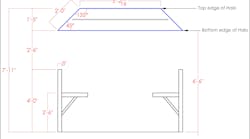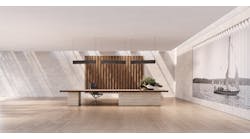ACOUSTICS 101 SERIES: Part 1 / Part 2 / Part 3 / Part 4 / Part 5 / Part 6 / Part 7
This month we focus on one of the worst acoustical offenders in modern office history.
The cubicle.
Designed in the 1960’s by Robert Propst to create freedom from social inequality in the workplace, the office cubicle concept was adapted and became status quo for large corporations with large numbers of employees and, consequently, large numbers of cubicles.
Good or bad, the fact is that cubicle environments are loud. Acoustically, they are large cacophonous noise boxes with uncontrolled sound from many, many sound sources. However, like many things of that era, (environmentalism, fossil fuel consumption, equal rights), acoustics was not considered an important topic and was consequently given little attention. Now it seems to be the hottest topic in architecture and design.
Cubicles are easy math. Take 500 sound sources (people on phones and computers) in 500 rooms (offices) and the noise is controlled: one room for every sound source, each sound source contained within its own space. Now take 500 people and put them all in one large room and the noise can be unbearable. In one particular gaming company’s office in Los Angeles, the ambient noise ranges from 85 to 100 dB SPL on an average day (think action film volume inside an office space).
Regardless of styles, history, technical evolution, or economy, office cubicles are not going away anytime soon, so let’s discuss a modern acoustical solution to this age-old issue.
As always, the first thing to do is identify the challenges and constraints of the situation. After that, we can create solutions knowing all the parameters of the situation.
- The challenges are high levels of noise, long reverberation and decay times, low intelligibility, lack of privacy, and decreased performance due to auditory fatigue.
- The constraints are fire sprinkler access, lighting access, visibility, transportability, effectiveness, and economy.
Acoustics in the Office: Challenges
With five decades of first-hand cubicle experience behind us, let’s briefly look at the challenges in greater detail.
- High levels of noise
- Simple. With no walls or enclosed spaces to keep noise from travelling from person to person, the noise sums across all sounds sources and becomes extremely high.
- This creates a high noise floor, which can be difficult to hear above and also dramatically reduces intelligibility.
- Long reverberation and decay times
- With distances between sound sources and hard reflective surfaces being even farther (person in cubicle to far end of office), the reverb times will increase.
- As cubicles provide minimal or insignificant acoustical control, decay times are left unaffected and therefore also very long. Sound energy is left untouched to bounce around large office spaces many, many, times. Long decay times also dramatically decrease intelligibility.
- Low intelligibility
- One of the main reasons for verbal communication is exactly that: communication. When intelligibility is low, people cannot understand what is being communicated, removing it’s entire purpose.
- Intelligibility is critical in office spaces (as well as most spaces where people talk to each other). Therefore it’s imperative that it be very functional or the communication and consequently the business itself will suffer.
- Lack of privacy
- For the sake of the acoustical conversation we’ll consider this a constraint, but in certain circumstances employers may consider this a benefit. As mentioned before, cubicles have minimal or negligible control of acoustics. Therefore, there is effectively no privacy when talking or meeting in a cubicle.
- This can lead to interpersonal conflicts based on overhearing private neighboring conversations. Even worse, private business details along with legal and discrete information can be overheard resulting in obviously difficult situations.
- A new trend is to have more conference rooms and train employees to move any private or sensitive conversations to them. However, this is not a complete solution if one is constantly having sensitive conversations, and it is a waste of large conference spaces. In addition, it becomes obvious that whenever someone runs off to a conference room they’re discussing something sensitive.
- Decreased performance and auditory fatigue
- It is a well-documented physiological fact that long exposure to loud noise has a fatiguing effect on the human psyche. This leads to slower response times and the inability to reason or problem solve.
- As a matter of fact, long-term noise at moderate levels has been used as a torture technique for many years due to its effectiveness and impact. Clearly a situation we would all rather avoid in our workplaces.
Acoustics in the Office: Constraints
Now let’s take a brief look at the constraints.
- Fire sprinkler access
- One of the benefits of cubicles is that fire sprinklers have enough access to reach within the cubicle walls, thanks to a lack of upper walls or ceilings. The obvious advantage is that it requires no additional time, labor, or code work to be done by the architect or city.
- Any new solution will have to address this safety issue while still allowing for open air access.
- Lighting access
- Again, as cubicles have no privacy and little separation, lighting is simply ambient light from above. General lighting for the entire floor will suffice for all the cubicles without any architect or city planner having to extend their scope of work.
- Any new solution will have to address the issue of lighting.
- Visibility
- Cubicles allow you to look over the walls across an entire office floor. You can see anyone standing, yet no one sitting unless they were in the cubicle next to yours. You can see who was just entering the space from the elevator, people going for coffee, or to the bathrooms. The caveat is that if there are no visible barriers, there are also no auditory barriers. This means everything said by anyone can be heard anywhere across the entire floor.
- Any new solution will have to not limit visibility yet control sound acoustically.
- Transportability
- Cubicles are relatively easy to setup.
- Any acoustical solution would have to be easy to setup, tear down, and move.
- Effectiveness
- Square foot for square foot, a new acoustical solution should be more effective in controlling reverberation, decreasing long decay times, and increasing intelligibility without having to cover large areas with traditional materials.
- Much like smart phones and electronics, acoustical solutions should be many times more effective per square foot of application than the previous generation of technology.
- Economy
- Any new solution must be affordable and easy to install preferably with well-known, existing methods.
- Any new solution must be affordable and easy to install preferably with well-known, existing methods.
Acoustics Solutions: Traditional Methods
A traditional solution is to use classic absorption and then hang it or cover the ceiling with it, as well as covering as much wall space as possible. The caveats to these solutions is that they’re limited in their installation locations by the busiest surface in any room: the ceiling. The acoustics would have to dodge fire sprinklers, pipes, lights, smoke alarms, structure, and conduits. Not to mention, traditional solutions--large hanging panels and/or flush mounted panels on the ceiling that don’t match the texture or color of the ceiling--are usually despised by interior designers and architects. An additional stipulation is that they don’t address low-frequency or mid-frequency sounds as the thickness and density of the material only has an effect upon high frequencies.
Acoustics Solutions: Modern Methods, Technology | True Acoustics
A modern, simple, and elegant solution is the ZR Halo. Just as it sounds, it’s a halo above each cubicle, suspended in the air space above standing height. It mirrors the outer edge of the cubicle and angles specifically toward the inside of it for maximum effectiveness (anywhere from 23-64 degrees depending on the size of the cubicle). The Halo controls sound emanating from the cubicle before it can reach the ceiling, thereby eliminating a large percentage of sound which decreases reverberation and decay times.
As most cubicles are rectilinear, so shall Halo be; a rectilinear halo. Aesthetic, lightweight, slender, and beautifully wrapped in elegant designer textiles (acoustically transparent of course), it is embedded with the latest in quantum acoustic technology on both top and bottom surfaces. Essentially every square inch of the Halo quantizes (vanishes) all sound energy that comes into contact with it—high frequency, mid frequency, low frequency, all frequencies. Environmentally, between 25–45 percent of all sound coming from each cubicle and as much as 50 percent of all ambient noise in the overall office floor space is eradicated. All in one elegant, architectural element.
Killing two birds with one stone, an added benefit of the Halo is the LED light strip by LiniLED/Orgatech on its upward facing side. The latest technology from Europe, Halo LED’s are fully dmx controllable, compatible with Lutron systems, have variable temperature lighting (2000K – 6000K), CRI values over 93, and full brightness control. The effect is a natural, indirect, diffused light off the ceiling’s clean, clear surface which is uninterrupted by less-than-attractive traditional acoustical panels wrapped in heathered, 70’s-style cloth. Hidden from sight, Halo LED’s are less expensive than exposed, suspended lighting fixtures and create greater visual control of each cubicle area by using wirelessly controlled, localized lighting.
Designed to be perfectly placed with its lowest edge at 6’6”, it leaves a 2’6” space above a cubicle wall for people to see the entire space and talk to each other while still controlling up to 45 percent of overall ambient sound (before it even has a chance to have a first reflection or become an issue). The height placement is designed to allow space for people as tall as 6’9” and as short as 5’0” to talk between cubicles while still creating an environment with dramatically increased intelligibility, clarity, and privacy.
Visibility is untouched as light pours in through the center of the Halo with additional indirect lighting flowing in from Halo’s LED lights, fire sprinklers reach each and every cubicle through the center of the Halo, and auditory fatigue is decreased by as much as 70 percent--increasing performance, mental acuity, and employees’ ability to reason and function.
Hung by the same airplane cable systems used in suspended lighting, Halo is lightweight and as easy to hang. Halo layouts are also simple, matching the floor plan and following the footprint of the cubicle.
The ZR Halo integrates all the needs of a space with a fluid, elegant design which is easy to implement, yet extraordinarily effective.
True Acoustics utilizes the principles of good design originated by Dieter Rams and applied by decades of designers worldwide.
Good design per dieter rams:
- Is innovative
- Makes a product useful
- Is aesthetic
- Makes a product understandable
- Is unobtrusive
- Is honest
- Is long-lasting
- Is thorough down to the last detail
- Is environmentally friendly
- Involves as little design as possible
Summary
The cubicle by nature has many acoustical downfalls which are tied directly to their benefits. Short of building an office for each and every employee, there are new technology solutions that can provide extraordinary effectiveness and control while providing an architectural, aesthetic, and code-worthy solution to an age old problem.
Join us next month when we’ll discuss yet another relevant and prescient conversation on acoustics in the field of architecture, interiors, and design.
ACOUSTICS 101 SERIES: Part 1 / Part 2 / Part 3 / Part 4 / Part 5 / Part 6 / Part 7


